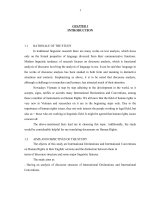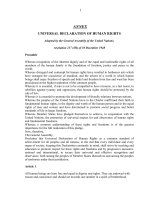silicate structures
Bạn đang xem bản rút gọn của tài liệu. Xem và tải ngay bản đầy đủ của tài liệu tại đây (686.5 KB, 31 trang )
Mineral Structures
Silicates are classified on the basis of Si-O polymerism
the [SiO4]4- tetrahedron
Mineral Structures
Silicates are classified on the basis of Si-O polymerism
[SiO4]4-
Independent tetrahedra Nesosilicates
Examples: olivine garnet
[Si2O7]6-
Double tetrahedra
Sorosilicates
Examples: lawsonite epidote
n[SiO3]2- n = 3, 4, 6
Examples: benitoite BaTi[Si3O9]
beryl Be3Al2[Si6O18]
Cyclosilicates
Mineral Structures
Inosilicates
[SiO3]2pryoxenes
single chains
pyroxenoids
Inosilicates
[Si4O11]4-
Double chains
amphiboles
Mineral Structures
Phyllosilicates
[Si2O5]2-
Sheets of tetrahedra
micas talc clay minerals serpentine
Phyllosilicates
Mineral Structures
Tectosilcates
low-quartz
[SiO2]
3-D frameworks of tetrahedra: fully polymerized
quartz and the silica minerals feldspars feldspathoids zeolites
Tectosilicates
Nesosilicates: independent SiO4 tetrahedra
b
c
M1 and M2 as polyhedra
Olivine (100) view blue = M1 yellow = M2
Nesosilicates: Olivine (Mg,Fe)2SiO4
Olivine Occurrences:
Principally in mafic and ultramafic igneous rocksTypically ~60+% of mantle source for basaltsFayalite in meta-ironstones and in some alkalic
granitoids
Forsterite in some siliceous dolomitic marbles
Nesosilicates: Garnet
Garnet: A2+3 B3+2 [SiO4]3
“Pyralspites” - B = Al
Pyrope: Mg3 Al2 [SiO4]3
Almandine: Fe3 Al2 [SiO4]3
Spessartine: Mn3 Al2 [SiO4]3
“Ugrandites” - A = Ca
Uvarovite: Ca3 Cr2 [SiO4]3
Grossularite: Ca3 Al2 [SiO4]3
Andradite: Ca3 Fe2 [SiO4]3
Occurrence:
Mostly metamorphic
Some high-Al igneous
Also in some mantle peridotites
Garnet (001) view blue = Si purple = A turquoise = B
Inosilicates: single chains- pyroxenes
b
a sinβ
Diopside: CaMg [Si2O6]
Where are the Si-O-Si-O chains??
Diopside (001) view blue = Si purple = M1 (Mg) yellow = M2 (Ca)
Inosilicates: single chains- pyroxenes
a sinβ
b
Diopside (001) view blue = Si purple = M1 (Mg) yellow = M2 (Ca)
Inosilicates: single chains- pyroxenes
(+) M2
The tetrahedral chain
above the M1s is
offset from that below
c
a
(+) M1
(+) M2
The result is a
monoclinic unit cell,
hence clinopyroxenes
e.g. Diopside, Augite
Inosilicates: single chains- pyroxenes
Orthopyroxene
c
(-) M1
an orthorhombic unit
cell
(+) M2
Enstatite (Mg2Si2O6)
a
(+) M1
(-) M2
Pyroxene Chemistry
The general pyroxene formula:
W1-P (X,Y)1+P Z2O6
Where
W = Ca Na
X = Mg Fe2+ Mn Ni Li
Y = Al Fe3+ Cr Ti
Z = Si Al
Anhydrous so high-temperature or dry conditions
favor pyroxenes over amphiboles
Pyroxene Chemistry
The pyroxene quadrilateral and opx-cpx solvus
Coexisting opx + cpx in many rocks (pigeonite only in volcanics)
Wollastonite
pigeonite
orthopyroxenes
Diopside
clinopyroxenes
cli
no
py
ro
xe
ne
s
1200oC
1000oC
Hedenbergite
Solvus
800oC
pigeonite
(Mg,Fe)2Si2O6
orthopyroxenes
Enstatite
Ferrosilite
Ca(Mg,Fe)Si2O6
Pyroxene Chemistry
“Non-quad” pyroxenes
Jadeite
NaAlSi2O6
Aegirine
NaFe3+Si2O6
0.8
Omphacite
aegirineaugite
Ca / (Ca + Na)
0.2
Ca-Tschermack’s
molecule CaAl2SiO6
Augite
Diopside-Hedenbergite
Ca(Mg,Fe)Si2O6
Inosilicates: double chains- amphiboles
b
a sinβ
Tremolite:
Ca2Mg5 [Si8O22] (OH)2
Tremolite (001) view blue = Si purple = M1 rose = M2 gray = M3 (all Mg)
yellow = M4 (Ca)
Inosilicates: double chains- amphiboles
b
a sinβ
Hornblende:
(Ca, Na)2-3 (Mg, Fe, Al)5
[(Si,Al)8O22] (OH)2
Hornblende (001) view dark blue = Si, Al purple = M1 rose = M2
light blue = M3 (all Mg, Fe) yellow ball = M4 (Ca) purple ball = A (Na)
little turquoise ball = H
Amphibole Chemistry
General formula:
W0-1 X2 Y5 [Z8O22] (OH, F, Cl)2
W = Na K
X = Ca Na Mg Fe2+ (Mn Li)
Y = Mg Fe2+ Mn Al Fe3+ Ti
Z = Si Al
Again, the great variety of sites and sizes → a great chemical range, and
hence a broad stability range
The hydrous nature implies an upper temperature stability limit
Amphibole Chemistry
Ca-Mg-Fe Amphibole “quadrilateral” (good analogy with pyroxenes)
Tremolite
Ca2Mg5Si8O22(OH)2
Anthophyllite
Mg7Si8O22(OH)2
Actinolite
Cummingtonite-grunerite
Orthoamphiboles
Ferroactinolite
Ca2Fe5Si8O22(OH)2
Clinoamphiboles
Fe7Si8O22(OH)2
Amphibole Chemistry
Hornblende has Al in the tetrahedral site
Geologists traditionally use the term “hornblende” as a catch-all term for practically
any dark amphibole. Now the common use of the microprobe has petrologists
casting “hornblende” into end-member compositions and naming amphiboles
after a well-represented end-member.
Sodic amphiboles
Glaucophane: Na2 Mg3 Al2 [Si8O22] (OH)2
Riebeckite: Na2 Fe2+3 Fe3+2 [Si8O22] (OH)2
Sodic amphiboles are commonly blue, and often called “blue amphiboles”
Amphibole Occurrences
Tremolite (Ca-Mg) occurs in meta-carbonates
Actinolite occurs in low-grade metamorphosed basic igneous rocks
The complex solid solution called hornblende occurs in a broad variety of both
igneous and metamorphic rocks
Sodic amphiboles are predominantly metamorphic where they are
characteristic of high P/T subduction-zone metamorphism (commonly
called “blueschist” in reference to the predominant blue sodic amphiboles
pyroxene
Inosilicates
amphibole
b
a
Cleavage angles can be interpreted in terms of weak bonds in M2 sites
Narrow single-chain I-beams → 90o cleavages in pyroxenes while wider doublechain I-beams → 60-120o cleavages in amphiboles
Phyllosilicates
SiO4 tetrahedra polymerized into 2-D sheets: [Si2O5]
Apical O’s are unpolymerized and are bonded to other constituents
Phyllosilicates
Tetrahedral layers are bonded to octahedral layers
(OH) pairs are located in center of T rings where no apical O
Phyllosilicates
a2
a1
Gibbsite: Al(OH)3
Layers of octahedral Al in coordination with (OH)
Al3+ means that only 2/3 of the VI sites may be occupied for charge-balance reasons
Brucite-type layers may be called trioctahedral and gibbsite-type dioctahedral









